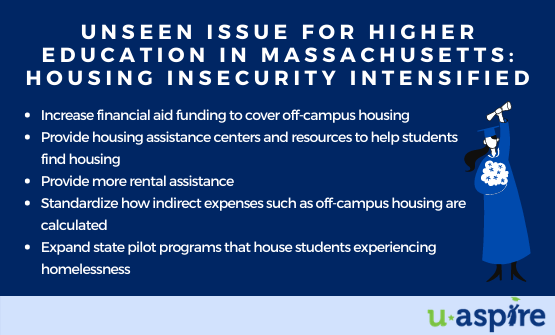Blogs
Unseen Issue for Higher Education in Massachusetts: Housing Insecurity Intensified
May 6, 2021
By Sarai Perez Camacho, Lesley Baez, Haowei Lee, and Janelle Sanon

Having a place to live is crucial for success in college. However, through the COVID-19 pandemic, many students and students’ families lost their jobs and income. With closing college campuses and constantly shifting financial situations, it is challenging for students to have enough money for housing. As Massachusetts students, we see first-hand how the lack of sufficient financial aid requires us to move frequently, take on several jobs, rent in low-quality housing, or stay in unsafe environments.
This memo presents our policy recommendations to ease the strain of housing insecurity amongst college students in Greater Boston. As students, we ask for increasing financial aid, standardizing how college costs are calculated, and increasing housing supports. These solutions have the potential to support students struggling to choose between being able to study and having a place to sleep.
Background
Some students attend college in their home community and can live with their parents, but many students do not have the option to live at home rent-free. For students without living on-campus nor with family options, they must compete for housing in the rental market. While rents have decreased in the past year, the average rent for a Boston studio apartment is $1,750 and one-bedroom apartment is $2,115. For a three-bedroom, the average rent is $3,115. When split between three students, that is over $1,000 per student. This means for the cheapest deal, the students need to work over 20 hours per week for the minimum wage ($13.50/hour) just to have a place to sleep, and that is on top of expenses for food, transportation, and course materials.
In 2019, thirteen Massachusetts public colleges and universities participated in a survey of student basic needs. Forty-three percent of respondents had experienced housing insecurity in the previous year and 17 percent had experienced homelessness.
Financial aid is available to college students to cover the cost of housing, however, there is not standardized guidance for colleges to calculate the cost of off-campus housing. A review of indirect expense estimates in the Boston area showed that estimates for indirect expenses for an off-campus student varied by $10,800 between colleges just two miles apart. This means that financial aid packages may not include sufficient funds to cover the actual off-campus housing costs and is a challenge for students as they attempt to calculate and plan for the cost of housing.
Recommendations
To support college students in affording their homes, we support five recommendations:
Increase financial aid funding to cover off-campus housing. Given that housing is already built into many financial aid packages yet on-campus housing is not always guaranteed, financial aid should increase to the mean cost of housing for off-campus apartments in the area.
Provide housing assistance centers and resources to help students find housing. A large issue for college students in finding housing is knowing where to start. Create housing assistance centers on college campuses for undergraduate students. These have staff members with institutional knowledge of the university’s geographical location to support students in finding housing and arming them against potential housing scams.
Provide more rental assistance. The state of Massachusetts already offers housing vouchers, but it can be difficult to qualify as a student due to factors such as yearly income and family size. Because of this, creating a rental assistance program specifically for college students would provide assistance while also not detracting from the needs of families in the area.
Standardize how indirect expenses such as off-campus housing are calculated. Improve guidance on how colleges and universities should calculate cost estimates for indirect expenses such as off-campus housing. Increased state and federal guidance would make estimated calculations more comparable from one college to the next and would ensure the housing cost estimates colleges are using to calculate the financial aid packages are accurate.
Expand state pilot programs that house students experiencing homelessness. Massachusetts is piloting a program that fully covers on-campus housing expenses for students experiencing homelessness, which includes funding for food and support for finding permanent housing. Increase funding to expand this program to serve more students.
In conclusion, many college students are drowning in financial stress that has only been compounded by the COVID-19 pandemic, and the subsequent loss of jobs has wreaked havoc on pre-existing housing insecurity. It is a significant challenge for students to upkeep rent payments amongst juggling other necessities they must cover. Students who struggle to finance school may choose to take a gap year, and some of them never return to complete their education. It is time that Massachusetts prioritizes relief for students. Presently, students are unable to focus on school when even a place to sleep is not guaranteed, and postsecondary outcomes are negatively impacted by the lack of student well-being of their students. By implementing one or more of these policy recommendations, the problem of expensive housing will begin to weigh less on students' shoulders, and students can focus on excelling at school and completing their education.